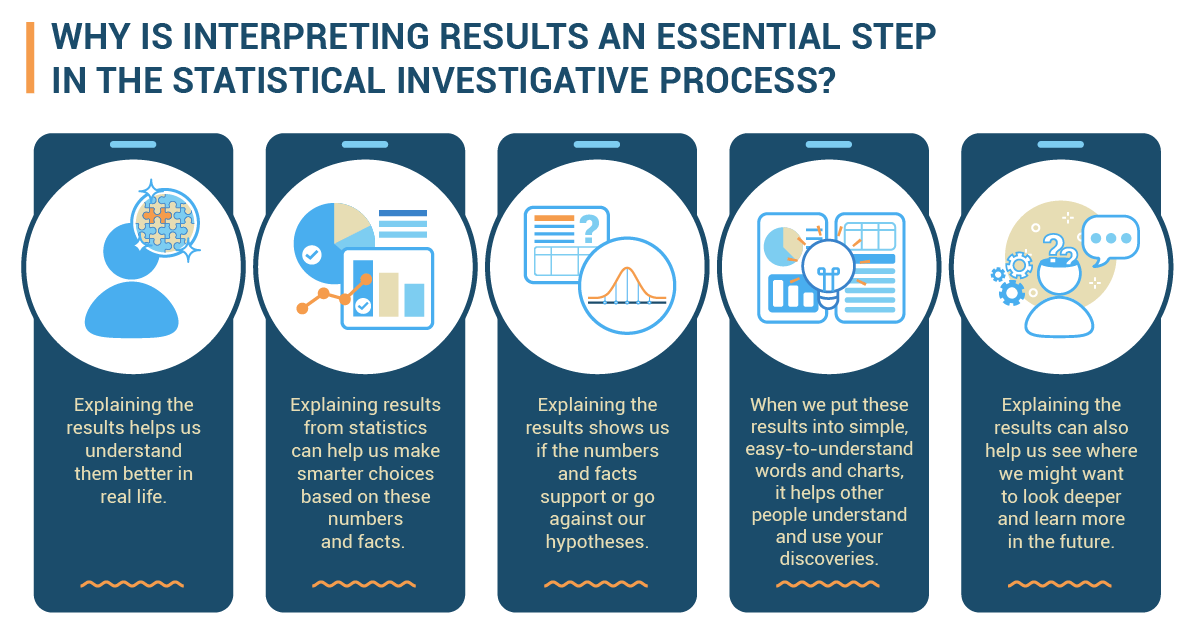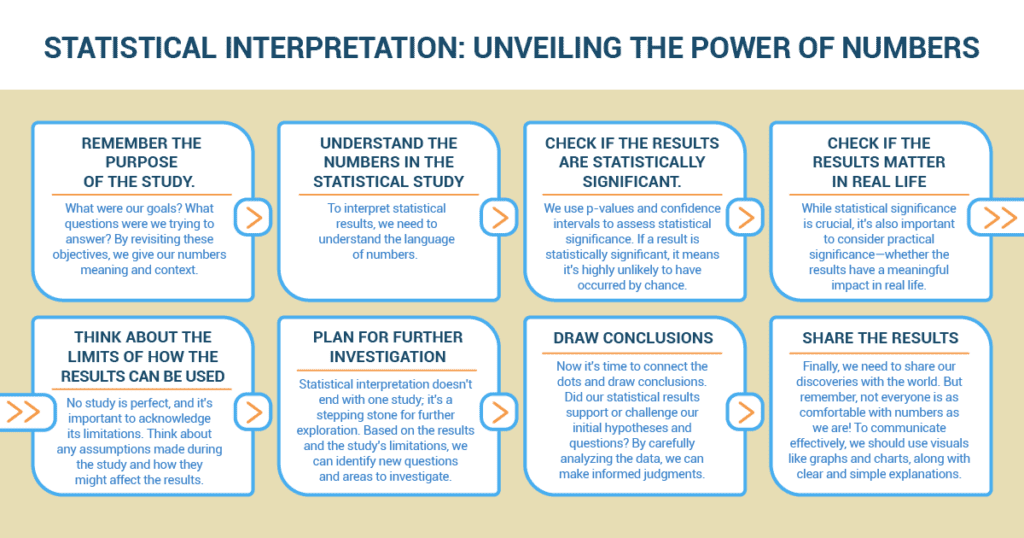 Think about those times when you’ve faced choices, big or small, that required careful consideration. Maybe you were trying to decide which movie to watch or which outfit to wear. In these moments, you instinctively gathered information and weighed the options. You, my friend, were interpreting the results, albeit on a smaller scale.
Think about those times when you’ve faced choices, big or small, that required careful consideration. Maybe you were trying to decide which movie to watch or which outfit to wear. In these moments, you instinctively gathered information and weighed the options. You, my friend, were interpreting the results, albeit on a smaller scale.
That’s right! Statistical interpretation is not just for the experts—it’s a valuable tool for each and every one of us. Today, we’re diving into what it means to interpret statistical results. It may sound fancy, but it’s all about understanding what those numbers and facts truly mean. So, grab your curiosity, and let’s explore why interpretation is such an essential step in the statistical investigative process.
Why is Interpreting Results an Essential Step in the Statistical Investigative Process?

Explaining the results helps us understand them better in real life.
Imagine you’re looking at a bunch of numbers and facts—maybe the average scores of your classmates on a recent math test. They might seem dull at first, like a puzzle missing its pieces. But when we explain those results, it’s like magic! We breathe life into those plain numbers and facts, giving them meaning that we can understand.
- For instance, let’s say the average math score is 85. That’s a pretty good score, right? Explaining this result tells us that most students did well on the test. We can celebrate our success and feel proud of our hard work.
Explaining results from statistics can help us make smarter choices based on these numbers and facts.
Now that we understand what those numbers mean, we can use them to make intelligent decisions in our lives. Statistics isn’t just about numbers on a page—it’s about real-life applications! Knowing what these numbers are telling us can help us in many situations.
- For example, imagine you’re starting a business selling delicious cookies. By analyzing statistical data, you can figure out which flavors are most popular among your friends and customers. This information guides you in making smart choices about what types of cookies to bake and sell, ensuring your business thrives!
Explaining the results shows us if the numbers and facts support or go against our hypotheses.
Have you ever had a hunch or a guess about something and wanted to see if it’s true? Well, interpreting statistical results can help us figure that out! When we have a hypothesis (a fancy word for an educated guess), we can use statistics to test it.
- Let’s say we hypothesize that taller students have higher scores in basketball. We can determine if our idea holds true by analyzing the statistical results. Our hypothesis is supported if the numbers show a clear relationship between height and basketball scores!
Putting these results into simple, easy-to-understand words and charts helps other people understand and use your discoveries.
Statistical investigation isn’t just about personal discovery—it’s about sharing knowledge with others. Explaining our results using simple words and charts is like turning on a light in a dark room. It helps others see what we’ve discovered and makes it easier for them to use that information, too!
- Let’s say you’re working on a research project about the effects of listening to music while studying. If you present your statistical findings in an easy-to-understand way, like a colorful bar chart, your classmates and teachers can grasp your discoveries quickly. This empowers them to make informed choices about their study habits and helps spread knowledge throughout your school community.
Explaining the results can also help us see where we might want to look deeper and learn more in the future.
Interpreting statistical results is like opening the door to more knowledge. Sometimes, the results might raise new questions or spark our curiosity to explore further.
- For example, suppose you’re studying the relationship between exercise and academic performance. Your statistical results may show that students who exercise regularly tend to have higher grades. This finding could motivate you to dig deeper into the reasons behind this connection. Are there specific types of exercise that are more effective? Does exercise affect different subjects differently? These new questions inspire further research and learning, leading to even more exciting discoveries!
The Steps in the Interpretation Stage of a Statistical Study
Now that we understand why interpreting results is important, let’s discuss decoding the secrets of statistical interpretation: unveiling the power of numbers. Here are some key steps in the process:
Step 1: Remember the purpose of the study.
What were our goals? What questions were we trying to answer? By revisiting these objectives, we give our numbers meaning and context.
- For example, imagine we’re investigating whether listening to music while studying affects test scores. Our goal is to determine if music has a positive or negative impact. By recalling our purpose, we can better understand how the statistical results relate to our initial inquiry.
Step 2: Understand the numbers in the statistical study.
To interpret statistical results, we need to understand the language of numbers. We’ll learn important statistics like mean (average), median (middle value), mode (most frequent value), standard deviation (how spread out the data is), correlation coefficients (how variables relate to each other), p-values (probability of results occurring by chance), and confidence intervals (range of values within which the true value is likely to fall).
- Let’s say we’re analyzing a survey about favorite pizza toppings. Understanding these statistics helps us see which toppings are the most popular and how strongly people feel about them. Armed with this knowledge, we can interpret the results with confidence.
Step 3: Check if the results are statistically significant.
Statistics can help us determine if our results are not just due to luck or randomness. We use p-values and confidence intervals to assess statistical significance. If a result is statistically significant, it means it’s highly unlikely to have occurred by chance.
- Imagine we’re investigating whether a new teaching method improves test scores. If our statistical analysis reveals a significant increase in scores among students who experienced the new method, we can confidently say that the improvement is not a fluke.
Step 4: Check if the results matter in real life.
While statistical significance is crucial, it’s also important to consider practical significance—whether the results have a meaningful impact in real life. Sometimes, statistical significance alone may not capture the full picture.
- For instance, let’s say a study finds that students who wear red socks score slightly higher on tests than those who wear blue socks. Although the result may be statistically significant, it may not be practically significant. The difference in scores might be so tiny that it doesn’t truly affect students’ academic success.
Step 5: Think about the limits of how the results can be used.
No study is perfect, and it’s important to acknowledge its limitations. Think about any assumptions made during the study and how they might affect the results.
- Suppose we’re investigating the impact of screen time on sleep quality. We need to consider factors like self-reporting bias (people not accurately reporting their screen time) or other variables (like caffeine intake) that may influence sleep quality but were not accounted for. Recognizing these limits ensures we interpret the results with caution.
Step 6: Plan for further investigation.
Statistical interpretation doesn’t end with one study; it’s a stepping stone for further exploration. We can identify new questions and areas to investigate based on the results and the study’s limitations.
- For example, we might want to dig deeper if our research reveals a positive correlation between physical activity and academic performance. Are certain activities more beneficial? Does the duration of exercise matter? These questions pave the way for future investigations and knowledge expansion.
Step 7: Draw conclusions.
Now, it’s time to connect the dots and draw conclusions. Did our statistical results support or challenge our initial hypotheses and questions? By carefully analyzing the data, we can make informed judgments.
- If we hypothesized that eating breakfast improves attention in class and our statistical analysis confirms a positive correlation, we can conclude that breakfast indeed plays a role in academic focus.
Step 8: Share the results.
Finally, we need to share our discoveries with the world. But remember, not everyone is as comfortable with numbers as we are! To communicate effectively, we should use visuals like graphs and charts, along with clear and simple explanations.
- Let’s say we conducted a survey on favorite music genres among high school students. Creating a colorful bar chart and describing the results in plain language will ensure that everyone understands and can appreciate our findings.
Exploring the Impact of Social Media
 Henry is curious about social media and how it affects us. He comes across a study about how social media affects teenagers’ well-being. He realizes that interpreting statistical results is really important. It helps us uncover important information about how social media impacts our lives.
Henry is curious about social media and how it affects us. He comes across a study about how social media affects teenagers’ well-being. He realizes that interpreting statistical results is really important. It helps us uncover important information about how social media impacts our lives.
Excited to learn more, Henry dives into the study’s findings. He learns about things like average numbers, like the mean and median, and how they’re used to understand the relationship between social media use and well-being in teens.
As Henry explores further, he discovers that spending too much time on social media can sometimes make people feel lonely or sad. The numbers show that there is a relationship between spending more time on social media and having lower levels of well-being.
But Henry knows that not all the findings are negative. He also learns that using social media in a positive and balanced way can have benefits, like feeling more connected to friends and being able to express yourself.
Henry understands that interpreting statistical results means looking beyond the numbers and thinking about how they relate to our real lives. He knows that it’s important to ask questions like: Do these results matter in our everyday life? Do they show something that’s really happening?
To make sure the results are trustworthy, Henry checks if the study was done properly and if the findings are significant. This means that the results are not just by chance and can be trusted to tell us something real.
Henry also keeps in mind that every study has its limits. He knows that the researchers might not have been able to ask every question or include every person. So, he considers these limitations when thinking about the results.
Henry’s journey doesn’t end there. He plans for further investigation by thinking about his other questions and what else he wants to learn about social media and well-being. He knows that this is just the beginning of understanding this complex relationship.
